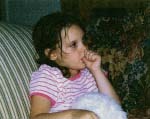Habits and Habit Disorders
A habit is a learned pattern of behavior that is repeated so often that it becomes automatic. Often there is a particular stimulus, or trigger, that activates the automatic behavioral response.
KEYWORDS
for searching the Internet and other reference sources
Behavioral therapy
Habit reversal
Obsessive-compulsive disorder
Tic disorders
What Is a Habit?
A habit is a learned behavior that a person repeats so often that he or she begins to do it without even thinking about it. Certain habits can be helpful, like the habit of brushing your teeth before going to bed or buckling your seatbelt when you get into a car. These are habits that a person builds on purpose, to achieve a positive objective.

Other habits may seem to serve no particular purpose, like hair twirling. These habits often are built unknowingly. They can include behavior like thumb sucking, nail biting, or chewing on the end of a pencil. Such habits may begin as self-soothing forms of behavior and may help relieve stress. But often, long after the need for that type of soothing is outgrown, the learned habit continues. Some habits are annoying, and some can cause distress or become the focus of teasing. Still others may have harmful effects. For example, thumb sucking, which can go on for years, can cause dental problems.
How Can You Break a Bad Habit?
Most habits can be changed with a bit of effort. When Tenesha wanted to stop biting her nails, she first tried to notice when and where she was biting them. She thought that her habit might have started as a way to relieve the stress she felt while concentrating hard on schoolwork in class. But she had had the habit so long that she bit her nails when she was doing her homework and even when she was sitting and watching TV. Tenesha decided that whenever she noticed her hands going toward her face, she was going to remind herself to stop. Then she was going to squeeze her fingers together for a moment instead of biting her nails. Tenesha tried this every day for a few weeks. Her nails started to grow in, and she rewarded herself with colorful nail polish. Her habit pattern was broken, and her fingers no longer went automatically to her mouth while she was doing schoolwork.
When a Habit Is Not Just a Habit
Most habits can be modified with a bit of effort if people make themselves aware of what they are doing. And the newer the habit (that is, the less practiced the habit), the easier it is to change. But some types of repetitive behavior or movements which may appear to be habits, such as an eye blink or the twitch of one side of a person's mouth, are actually involuntary (that is, they cannot be controlled). For reasons that are not yet clear, such repetitive movements, called tics, can become increasingly frequent and recur in combination with other tics. Stress and fatigue are known to play a role in making tics more frequent.
A condition called Tourette syndrome (also called Tourette disorder) causes a person to have repeated involuntary jerky movements (motor tics), make facial grimaces, and repeat certain sounds or words out loud (vocal tics). These tics can seem surprising and odd to others, who do not understand what is causing them. Another condition called trichotillomania (TRIK-o-til-o-MAY-ni-a) involves the "habit" of pulling out one's own hair, eyebrows, or eyelashes. This is more than a simple habit and stems from powerful urges, produced in the brain, to pull hair. Obsessive-compulsive disorder (OCD) causes people to become trapped in a pattern of repeated unwanted and upsetting thoughts, called obsessions (ob-SESH-unz), and a pattern of repetitive behavior or rituals, called compulsions (kom-PUL-shunz). Rituals (compulsions) are behavioral "habits" that a person with OCD feels the need to repeat over and over again to relieve stressful feelings. While the reward of "relief from anxiety" may play a part in OCD, there is growing evidence that OCD and these other habit-like conditions are the result of involuntary messages sent from nerves in a particular part of the brain. Rituals, compulsive hair pulling, tics, and other repetitive behavior can be very distressing to the person experiencing them. Fortunately, these conditions can be diagnosed and usually treated successfully by mental health professionals.
Behavior therapy techniques are particularly helpful in treating these habit-like disorders. A technique called habit reversal, in which a person learns to substitute a different behavior for the "habit" he or she is trying to control, is effective with trichotillomania. Exposure and ritual prevention is a behavior therapy technique which can effectively manage symptoms of OCD. A person places him or herself in a situation that usually triggers the ritual behaviors. With the help of a therapist, the person learns to apply new methods for coping with the stress caused by the situation, instead of using the ritual to relieve the stress. With supported practice, the stress diminishes and the rituals can be eliminated.
Comment about this article, ask questions, or add new information about this topic: